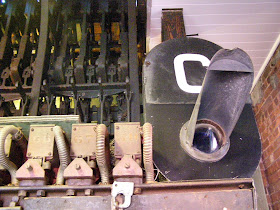In fact, I had heard that the LIRR had been using the "Flashing Green" aspect to indicate Absolute Block Clear. It had never seen it, but it made sense. Not to mention they had Manual Block Clear as an existing option as well. A quick google search actually found a previously unknown LIRR signal rule reference.
NAME: Absolute-Clear.Yeah, there you go. If you want to go to color light, just use *G*/R. A nice uniform difference from NORAC Cab Speed.
INDICATION: Proceed; Track clear to next interlocking signal. Approach next interlocking signal prepared to stop.
Huh? *G*/*R*? That's a bit...odd. I guess they really want to make it different from anything that might appear in the Amtrak zone? Wait a minute...what's that in the text of Rule 298B?
Absolute Medium Clear? Absolute Slow Clear? Oh no..
NAME: Absolute-Medium-clear.
INDICATION: Proceed; Medium Speed within interlocking limits. Track clear to next interlocking signal. Approach next interlocking signal prepared to stop.
Are you kidding me? This is the sort of think a child would come up with for their imagination railroad. Oh wait, it gets crazier.
NAME: Absolute Slow-clear.
INDICATION: Proceed; Slow speed within interlocking limits. Track clear to next interlocking signal. Approach next interlocking signal prepared to stop.
Yup, that is a flashing three headed signal. I mean I guess I see the logic. The LIRR doesn't use flashing signals outside of the Amtrak zone so this associates flashing with an absolute block while not duplicating any existing signal aspects.
NAME: Slow-approach
INDICATION: Proceed approaching next signal prepared to stop. Slow speed within interlocking limits
Ok, I guess that brakes the pattern. Wait, on the PRR Slow Approach can stand in for Slow Clear on high signals. What does the LIRR do there?
NAME: Flashing Slow-approach.
INDICATION: Train will proceed in accordance with signal indication within interlocking limits and after clearing the interlocking, proceed under absolute clear indication to the next interlocking.
They named a signal indication "Flashing Slow Approach". I guess the other three signal rules used up all their creativity juice. The fact that I only became aware of all this now just shows the extent to which the LIRR keeps its operating practices under wraps. To be fair, this isn't as crazy as it appears. Like I said, when this was developed in the 1970's the LIRR had avoided flashing signal aspects and also wanted to avoid conflicts with Amtrak zone signals (although there was and is no wayside-free operation in the Amtrak zone). In the relay hut logic could use a single flashing circuit applied to the entire output of a signal when an Absolute Block signal was called for AND the system avoids the odd case of a "Clear to Next Interlocking" displayed along side an Approach signal, which can happen under NORAC despite being redundant.
 |
| This here is how you do absolute block. End of discussion. |
 |
| Metro-North started fresh in 1983 and first choose the PRR solution. |































